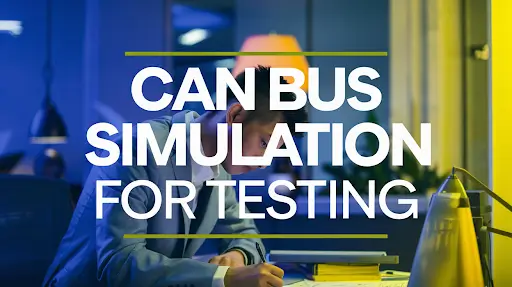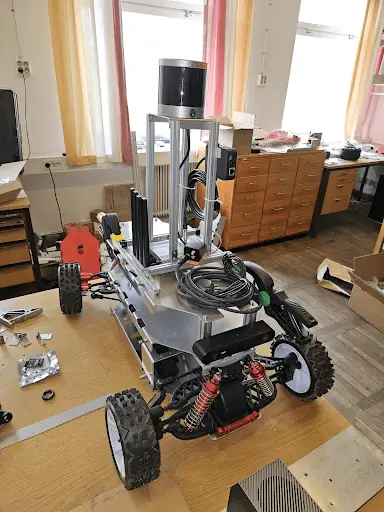CAN Bus Simulation for Effective System Testing and Validation

Introduction
At CanEduDev, we understand the critical importance of robust testing and validation in the development of modern automotive and industrial systems. Our CAN Development & Education Kits, including the versatile Demo Rover, are designed to facilitate comprehensive testing through CAN (Controller Area Network) bus simulation. This guide highlights the advantages of CAN network simulation and provides a practical approach to setting up and using a CAN bus simulator for system design validation, with a particular focus on understanding CAN message composition and message frequency.
Benefits of CAN Network Simulation
Cost-effective Testing
CAN bus simulation enables engineers to conduct extensive testing without the need for expensive physical hardware, significantly reducing overall development costs. This is particularly beneficial for prototyping and experimenting with various configurations of CAN messages before moving on to physical systems.
Reproducible Test Environments
With CAN simulators, you can create consistent, repeatable test conditions, ensuring reliable results across multiple test runs, which is critical in testing and improving both CAN protocol design and system robustness.
Accelerated Development
Virtual testing through simulation allows for rapid iteration, debugging, and analysis of the CAN message structure, composition, and frequency, speeding up the overall development cycle and allowing for early-stage validation.
Scalability
Simulators can model complex networks with multiple nodes and varied message traffic, providing a scalable solution for testing systems of any size. The Demo Rover, for instance, uses a variety of CAN messages to control the motor, steering, and battery operations, making it an excellent platform for learning about CAN system scaling.
Error Injection
Controlled fault introduction is essential for assessing system robustness. Our CAN bus simulators allow for precise error injection, enabling the simulation of real-world conditions such as message collisions or incorrect data rates, helping engineers develop stronger fault-tolerant systems.
Time-saving
Automated testing scripts can execute numerous scenarios swiftly, reducing the time and effort needed for manual testing. With predefined CAN messages in the Demo Rover (such as those controlling servo positions or motor speeds), engineers can quickly simulate various real-world conditions.
Setting Up a CAN Bus Simulator
Choose Simulation Software
Select a CAN simulation tool that integrates seamlessly with your development environment.
One excellent choice is CanKing from Kvaser, a powerful and easy-to-use software for monitoring and simulating CAN bus traffic. CanKing provides a graphical interface that simplifies the analysis of CAN messages, allowing users to log, filter, and simulate traffic. It is ideal for both beginners and professionals working with CAN networks.
In addition to CanKing, other tools like Vector CANoe, PCAN-Explorer, or open-source alternatives like SocketCAN are available. These tools offer in-depth capabilities for analyzing CAN message structure, scheduling messages within a network, and evaluating system performance under different traffic conditions.
Define Network Topology
Create a virtual model of your CAN network, including all nodes and their interactions. For example, the Demo Rover includes nodes for motor control, steering, and power management. Simulating these interactions helps students and professionals understand how various components communicate in a real CAN-based system.
Configure Node Properties
Set up each node with necessary identifiers, message structures, and transmission rates to mimic real-world conditions. This step includes configuring the Demo Rover’s steering and throttle control messages using CAN message IDs, such as the throttle message for controlling motor speed.
Implement Message Scheduling
Define the timing and priority of messages within the network to replicate operational scenarios accurately. The Rover’s message frequency can be adjusted, offering insight into how message intervals and real-time constraints affect system performance.
Create Test Cases
Develop a series of test scenarios to cover both normal operations and edge cases. Testing the Demo Rover’s CAN message composition, such as servo voltage regulation or battery monitoring, helps validate the system under different load conditions.
Using the Simulator for System Validation
Basic Functionality Testing
Verify that all nodes in the network can send and receive messages as expected, ensuring basic communication integrity. The Rover’s servo, motor, and battery nodes each send specific status messages, which can be simulated for system validation.
Load Testing and Timing Analysis
Simulate high-traffic scenarios to evaluate network performance under stress. Measure message latencies and ensure that the system meets critical timing requirements. The ability to schedule message frequencies for the Demo Rover’s modules allows students and engineers to explore how bus load affects real-time system constraints.
Error Handling
Introduce deliberate errors, such as incorrect message frequency or message loss, to test the resilience of your system.
Integration Testing
Simulate interactions between multiple subsystems, such as the Rover’s motor and steering systems, to identify potential conflicts or integration issues.
Regression Testing
Use automated test scripts to verify system stability after design changes, ensuring that updates do not introduce new issues. By modifying the Rover’s CAN message parameters, engineers can quickly assess the impact of these changes on system performance.
Conclusion
CAN bus simulation is an invaluable tool for system designers and testers at CanEduDev. By leveraging virtual environments and the Demo Rover’s extensive CAN message structure, engineers can thoroughly validate CAN-based systems, identify potential issues early in the development cycle, and ensure robust, reliable performance in real-world applications. Whether you’re using the Demo Rover or another product from our CAN Development & Education Kits, the insights gained from CAN simulation are indispensable for CAN protocol and system design.
Contact Information
For more details or inquiries, please reach out to Hashem Hashem, Lead Engineer, at hashem@canedudev.com.
our other blogs
CanEduDev Rover: Progress Report on System Integration and Architecture
CanEduDev Rover: Technical Progress Update on System Integration We are excited to share a detailed update on the ongoing development of the CanEduDev Rover, a key project within our collaboration wi...
read moreCanEduDev Partners with KTH and Telenor on Advanced Autonomous Driving Project
Project SummaryThe collaboration between CanEduDev, the Royal Institute of Technology (KTH), and Telenor represents a pioneering effort to push the boundaries of autonomous driving technology on a sma...
read moreUnlocking the Future with CanEduDev Rover and ROS2 Integration
In an era where rapid advancements in automation and robotics are reshaping industries, real-time data acquisition, flexible control, and robust integration have become critical. To meet these demand...
read moreCanEduDev formally partners with Kvaser
As a newly appointed Technical Associate to Kvaser, CanEduDev is set to bring its Rover platform to the forefront of CAN technology demonstrations and education. This collaboration underscores our sh...
read more


